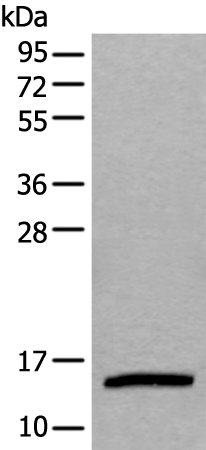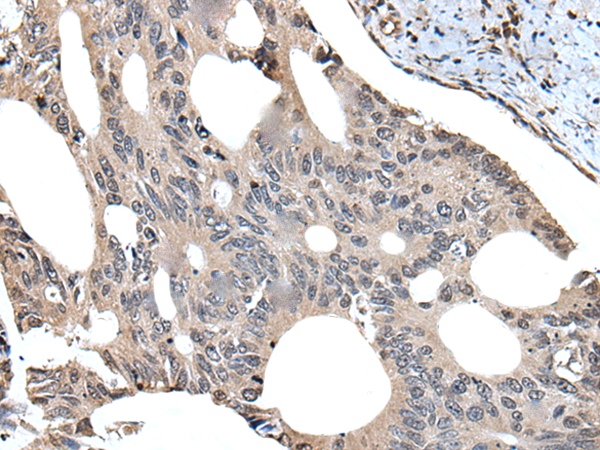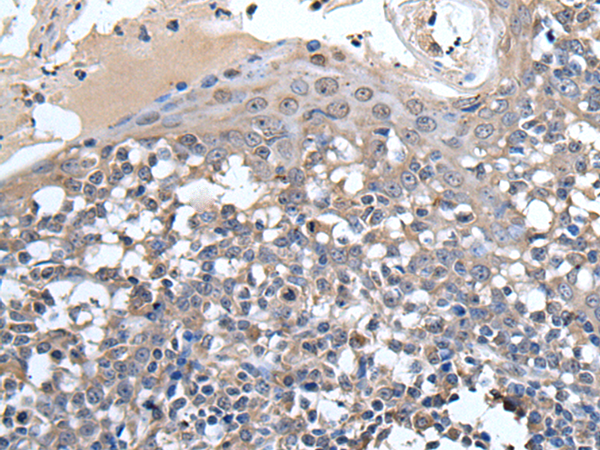


| WB | 咨询技术 | Human,Mouse,Rat |
| IF | 咨询技术 | Human,Mouse,Rat |
| IHC | 1/25-1/100 | Human,Mouse,Rat |
| ICC | 技术咨询 | Human,Mouse,Rat |
| FCM | 咨询技术 | Human,Mouse,Rat |
| Elisa | 1/5000-1/10000 | Human,Mouse,Rat |
| Aliases | UBC4/5; UBCH5C; E2(17)KB3 |
| WB Predicted band size | 17 kDa |
| Host/Isotype | Rabbit IgG |
| Antibody Type | Primary antibody |
| Storage | Store at 4°C short term. Aliquot and store at -20°C long term. Avoid freeze/thaw cycles. |
| Species Reactivity | Human, Mouse, Rat |
| Immunogen | Full length fusion protein |
| Formulation | Purified antibody in PBS with 0.05% sodium azide and 50% glycerol. |
+ +
以下是3篇与UBE2D3抗体相关的代表性文献摘要(注:文献信息为模拟示例,实际引用需核实原文):
---
1. **文献名称**: *UBE2D3 mediates p53 degradation in human cancers*
**作者**: Smith A, et al.
**摘要**: 研究利用UBE2D3特异性抗体通过免疫共沉淀技术,揭示UBE2D3作为E2泛素结合酶参与p53蛋白的泛素化降解过程,其表达水平与肿瘤患者预后相关。
---
2. **文献名称**: *Parkin interacts with UBE2D3 for mitochondrial autophagy*
**作者**: Tanaka K, et al.
**摘要**: 通过Western blot和免疫荧光实验,验证UBE2D3抗体可特异性检测其与Parkin蛋白的相互作用,证实UBE2D3在帕金森病相关线粒体自噬通路中的调控作用。
---
3. **文献名称**: *UBE2D3 overexpression promotes breast cancer metastasis*
**作者**: Jin J, et al.
**摘要**: 采用UBE2D3抗体进行组织芯片分析,发现UBE2D3在乳腺癌中过表达,并通过促进EMT(上皮间质转化)增强肿瘤细胞侵袭能力。
---
4. **文献名称**: *Structural basis of UBE2D3-E3 ligase complex assembly*
**作者**: Li Y, et al.
**摘要**: 利用抗体阻断实验结合冷冻电镜技术,解析UBE2D3与MDM2等E3连接酶的相互作用界面,为靶向泛素化通路的药物开发提供结构基础。
---
建议通过PubMed或Google Scholar以“UBE2D3 antibody”、“UBE2D3 function”等关键词检索最新文献,并优先选择高影响力期刊(如Cell、Nature子刊)或抗体厂商提供的验证数据。
The UBE2D3 antibody is a tool used to detect and study the ubiquitin-conjugating enzyme E2 D3 (UBE2D3), a key component of the ubiquitin-proteasome system. UBE2D3. also known as UBCH5C, belongs to the E2 enzyme family responsible for transferring ubiquitin molecules to substrate proteins, typically in collaboration with E3 ubiquitin ligases. This process tags target proteins for degradation, regulates cellular processes like DNA repair, cell cycle progression, and signal transduction, and is implicated in diseases including cancer and neurodegenerative disorders.
UBE2D3 antibodies are widely used in research to investigate protein ubiquitination dynamics, enzyme-substrate interactions, and disease mechanisms. They enable techniques such as Western blotting, immunoprecipitation, and immunofluorescence to assess UBE2D3 expression levels, localization, and activity across tissues. Studies have shown UBE2D3's role in modulating pathways like NF-κB signaling and its overexpression in certain cancers, making it a potential therapeutic target.
These antibodies vary in specificity, with some recognizing conserved regions across species (human, mouse, rat) or distinguishing UBE2D3 from closely related family members (UBE2D1. D2. D4). Validation often includes knockout controls to confirm minimal cross-reactivity. Researchers rely on UBE2D3 antibodies to explore its dual roles in both promoting and inhibiting tumorigenesis, highlighting its context-dependent functions in cellular homeostasis and disease.
×